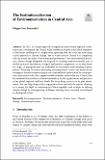The institutionalisation of environmentalism in Central Asia
Abstract
In 2021, in a largely ignored yet significant step towards regional coordination and convergence, the Central Asian republics took part in the 26th Conference of the Parties in Glasgow as a single entity, speaking with one voice and advocating a joint approach to climate change. Yet, to what extent is Central Asia complying with the norms and rules of environmental governance? Are environmental protection, climate-change mitigation and the push for an energy transition merely a set of shallow practices and rhetoric to signal performative compliance, or are they based on a logic of appropriateness and embedded in a normative understanding of green politics? Drawing on recent scholarship on international society and based on the assumption that environmentalism is now an established institution of the contemporary international order, this chapter considers whether, and in what way, Central Asia has embraced the institution of environmentalism, exploring discourses and practices at the global, regional and local levels. Far from being an exercise in pure theorisation, this can help shape policy engagement from and with the region, allowing us to assess the depth of commitment of these republics and societies in fighting climate change by distinguishing challenges deriving from structural, instrumental or ideological factors.
Citation
Costa Buranelli , F 2023 , The institutionalisation of environmentalism in Central Asia . in R Sabyrbekov , I Overland & R Vakulchuk (eds) , Climate change in Central Asia : decarbonization, energy transition and climate policy . SpringerBriefs in climate studies (BRIEFCLIMATE) , Springer , Cham , pp. 137-148 . https://doi.org/10.1007/978-3-031-29831-8_11
Publication
Climate change in Central Asia
ISSN
2213-784XType
Book item
Collections
Items in the St Andrews Research Repository are protected by copyright, with all rights reserved, unless otherwise indicated.

